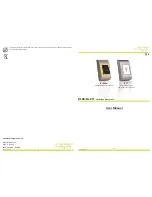
Communication Setup (Cable Configuration)
4-5
Publication 2755-6.2
Hardware Handshaking
When enabled, handshaking verifies the readiness of a receiving device
before data is transmitted. You can enable or disable the hardware
handshaking lines. The DTR (Data Terminal Ready) signal is either
active high or low (see below).
This is how the scanner handshaking functions:
1. The scanner checks the Clear to Send (CTS) line. If CTS is active,
the scanner will wait for up to 2 seconds and check the line again. If
the line is still active, the scanner will provide an audible beep and
any scanned data will be lost.
2. If the CTS line is not active, the scanner will assert the Request to
Send (RTS) line and wait for two seconds for the host to assert the
CTS line. When the host asserts the CTS line, the scanner transmits
the data.
3. After the transmission is completed, the scanner will negate the RTS.
4. The host device should then negate CTS. The scanner checks the
CTS line on the next transmission.
RTS State
Selects the active state for the Request to Send (RTS) signal.
Make sure that this setting matches the requirements of the host device.
The selections are:
•
RTS State Low (default)
•
RTS State High
















































